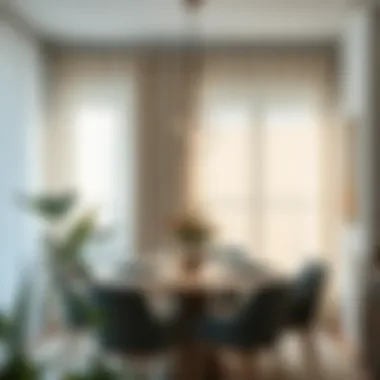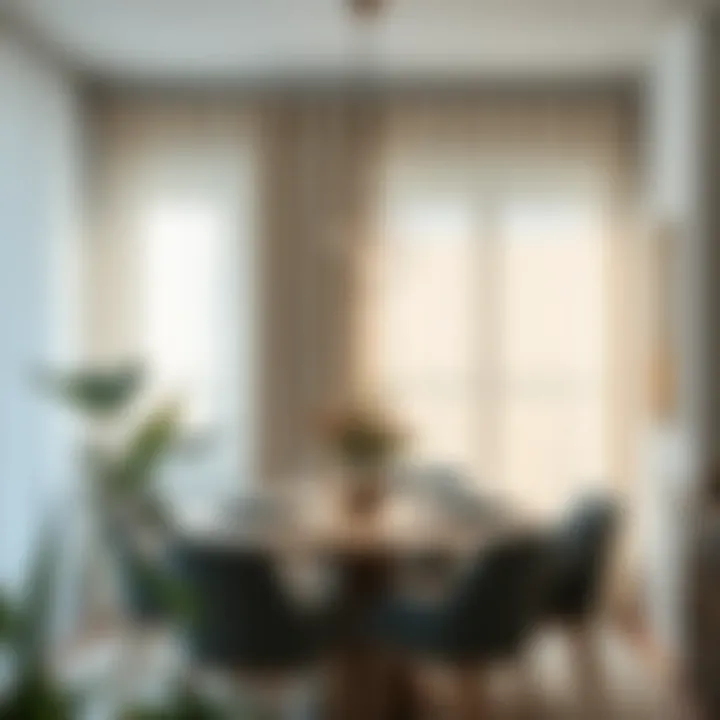Maximizing Style with 62-Inch Long Curtains


Intro
The world of interior design is an ever-evolving landscape where the subtleties of style and practicality intertwine seamlessly. Among the myriad choices that a homeowner or decorator faces, curtains hold a special place. Especially 62-inch long curtains, they strike a fine balance between length and functionality, making them versatile additions to any room.
In this guide, we will journey through the multifaceted characteristics of these curtain styles. We will explore their role in enhancing aesthetics, their practicality in daily life, and how they can be tailored to meet specific design needs. Think of it as a deep dive into the art of layering light and color — each choice you make regarding fabric, style, and even installation method adds to the overall feel of your space.
From modern minimalism to vintage charm, 62-inch long curtains cater to an array of tastes and functional requirements. And whether you are looking to block the morning sun or simply add a touch of elegance to your living room, this guide will be your go-to resource. Let’s unravel the threads of design together.
Understanding Curtain Length
When it comes to selecting curtains, understanding the right length is often the unsung hero of interior design. Many people may not give it much thought, but the length of your curtains can dramatically affect not only the aesthetics of a room but also its functionality. The right curtain length can make a space feel taller, cozier, or even more vibrant, depending on the chosen style and material. For homeowners, interior designers, and DIY enthusiasts alike, knowing how to effectively utilize length in curtain choices can lead to smarter buying decisions and more harmonious living spaces.
Defining Standard Heights
Curtains come in various lengths, and defining what is standard is crucial. In most households, standard curtain lengths usually range from 63 inches to 120 inches. However, the 62-inch mark is often overlooked, although it has its unique benefits. Typically, this length works well for windows in average-sized rooms as it hits just above the window sill, creating a sense of balance without overwhelming the space.
In casual settings, a curtain that falls right at the sill can appear relaxed and welcoming, making it suitable for kitchens or informal dining areas. This specific height can also provide a cleaner line in spaces that require a bit of polish without going overboard. Keep in mind that the style of your home may guide you in picking the curtain length; traditional homes might benefit more from longer drapes, whereas contemporary designs often embrace the shorter 62-inch curtains.
Measuring for the Perfect Fit
Taking accurate measurements is the cornerstone of achieving the perfect fit for your curtains. Many homeowners might think this step is straightforward, but a precise measurement can make a world of difference.
- Window Height: Begin by measuring from the top of the window frame to the desired point where you'd like the curtain to end. If you choose 62-inch curtains, measure carefully; get the height right to avoid cut-off or floor-dragging looks.
- Rod Placement: The height of your curtain rod also plays a big role. It's usually recommended to hang it 4 to 6 inches above the window to give an illusion of height. Always consider the rod's style and thickness, as it can affect how the curtain falls.
- Consider the Style: If you're going for a more fashionable look, you might want to opt for a higher rod placement, even higher than the 6-inch mark. This could give your room a more airy, open quality.
- Final Adjustments: Lastly, always account for alterations. If your measurements are spot on, you’re much more likely to achieve a perfect installation.
"Good measurements today mean a stylish room tomorrow."
Overall, understanding the nuances of curtain length, with specific attention to 62-inch options, paves the way for more aesthetic and functional decisions in home interiors.
The Aesthetic Appeal of 62-Inch Curtains
When it comes to interior design, the aesthetic appeal of 62-inch curtains shouldn't be underestimated. These curtains can serve as both functional pieces and stylish additions to any room. Not only do they help in controlling light and ensuring privacy, but they also offer a chance to express personal style through fabric, color, and design. This section will explore how 62-inch curtains can enhance various spaces, highlighting different styles and their unique contributions to interior aesthetics.
Adding Style to Any Room
Curtains are not just a functional element; they’re also a chance to introduce a new layer of design into your living space. Here are some styles of 62-inch curtains that stand out in terms of decorative appeal.
Traditional Styles
Traditional styles of curtains often draw on classic patterns and rich fabrics, enriching a space with a sense of history and warmth. One key characteristic of traditional curtains is their heavy fabrics, such as velvet or brocade, which create a luxurious feel. This style is popular for formal spaces like living rooms and dining rooms, where elegance is a priority.
The unique feature of traditional curtains lies in their ornate detailing, like tassels or embroidered patterns, offering a touch of sophistication. However, one disadvantage might be their weight and bulkiness, which can overshadow other design elements in a room if not styled properly.
Modern Interpretations
Modern interpretations of curtains lean into simplicity and sleekness, aligning with contemporary design philosophies. These types often feature minimal patterns and lightweight fabrics, contributing to an airy and uncluttered look. A defining characteristic of modern curtains is their use of neutral tones or bold color blocks, making them versatile enough for various decor styles.
The unique feature here is their ability to blend seamlessly with modern furniture and fixtures, adding style without overwhelming the space. Still, their simplicity may sometimes clash with more traditional elements in a home, thus requiring a careful pairing with other decor items to maintain balance.
Eclectic Choices
Eclectic choices in curtain design embrace a mix of different styles, patterns, and colors. This flexibility allows homeowners to create unique, personalized spaces that reflect individual tastes. A significant aspect of eclectic curtains is their variety—think vibrant floral prints paired with geometric designs.
The appeal of eclectic options lies in their ability to bring life and character to a room. They can complement a wide array of decor themes, from bohemian to retro. However, in some cases, the risk of clashing patterns could overwhelm the senses if not curated thoughtfully. Finding harmony in the chaos becomes the key with this style.
Complementing Other Interior Elements
The aesthetic appeal of 62-inch curtains is heightened by their ability to complement other elements within a room. They can bridge the gap between different textures and colors, enhancing the overall style story. For instance, pairing heavy drapes with light, airy furniture can create a striking contrast that draws the eye and adds depth to the design.
Additionally, curtains can accentuate architectural features like windows and moldings, making them feel more significant in a room. A well-chosen set of curtains can also harmonize with rugs, cushions, and wall colors, creating a cohesive look that speaks to the homeowner's unique style. Ultimately, the thoughtful selection of 62-inch curtains can act as a unifying thread in the fabric of your home’s décor.
Functionality of Curtain Length
When it comes to curtains, few factors matter as much as their functionality. The length of a curtain significantly influences how well it performs its various roles within a space. Specifically, 62-inch long curtains strike a balance between aesthetics and practicality, making them an excellent choice for many rooms. Let's break this down into two key areas: light control and privacy, as well as energy efficiency.
Light Control and Privacy
Curtains are more than just a decorative touch; they serve essential functions in regulating light and ensuring privacy. The choice of curtain length affects how effectively these functions are performed.


A 62-inch curtain can be particularly effective for standard-sized windows, offering optimal coverage while still allowing some control over how much light seeps in. Homeowners often find that these curtains can be drawn partially or fully to let light in or block it out, providing flexibility according to the time of day or mood.
Moreover, incorporating blackout lining or thicker fabrics increases the effectiveness of light control. You'll find that these curtains can turn a bright room into a cozy retreat with just a simple pull. The balance between light and privacy is crucial, especially in urban settings where close proximity to neighboring properties can create discomfort. In this case, 62-inch long curtains can shield against prying eyes without making a room feel too enclosed.
"For many homeowners, the choice of curtain length directly impacts the atmosphere and functionality of their living spaces."
Energy Efficiency Considerations
Another aspect that often goes under the radar is how curtain length influences energy efficiency in the home. 62-inch curtains can help maintain comfortable room temperatures by acting as an insulating barrier. When the sun's rays beat through windows, light-colored or reflective curtains can minimize heat gain during summer months. Conversely, heavier fabrics can help retain warmth during winter, reducing the need for heating.
When selecting curtains, consider the type of fabric you confront. Fabrics that boast thermal insulation qualities typically provide significant benefits, ensuring energy costs stay in check. Here’s a quick list of ways your curtain choices can enhance energy efficiency:
- Material Selection: Opt for thermal-lined or insulated fabric.
- Layering: Combine sheer and thick fabrics for both aesthetics and functionality.
- Proper Installation: Ensure that curtains hang close to the window frame to maximize their efficiency.
By implementing such strategies, homeowners not only enhance their comfort but also create more sustainable living environments. Choosing 62-inch long curtains can thus be a pivotal step towards improving energy efficiency while adding a stylish touch.
Material Choices for 62-Inch Curtains
When it comes to choosing curtains, the material is just as important as the length. The fabric you select can greatly impact not only the appearance but also the functionality of the curtains. Since we are focusing on 62-inch long curtains, understanding the various material options available will help you make informed decisions that align with your home’s aesthetics and your practical needs.
Popular Fabric Options
Cotton
Cotton is a go-to material for many homeowners, and it’s easy to understand why. This fabric is not only soft and breathable but also available in a wide array of colors and patterns. When selecting 62-inch long curtains made from cotton, you’re opting for versatility. One key characteristic of cotton is its ability to blend well with different styles—from cozy country cottages to sleek modern apartments.
"Cotton curtains enhance any room's comfort level, making them an all-time favorite."
Cotton’s main advantage lies in its ease of care, as most cotton curtains are machine washable. However, they can crease easily, so if you prefer a more polished look, you might need to iron them regularly. Nevertheless, cotton remains a popular choice for its balance between practicality and style.
Linen
Linen is often seen as the classy cousin of cotton. This fabric has a unique texture that brings elegance to any space. High-quality linen will have a slight sheen, which adds an upscale feel to your decor. The lightness of linen allows sunlight to filter through beautifully; it maintains a certain airy quality that can make a room feel larger.
One notable feature of linen is its natural ability to resist dust mites and other allergens, making it a great option for health-conscious homeowners. But it’s worth mentioning that linen typically requires dry cleaning, as washing it might lead to shrinkage or loss of shape. If you’re looking to add a touch of sophistication while being mindful of cleanliness, linen is certainly a material to consider.
Synthetic Varieties
Synthetic fabrics, such as polyester or nylon blends, offer a different approach for 62-inch curtains. These materials are prized for their durability and resistance to fading and wrinkling. One advantage of synthetic varieties is their affordability—often less expensive than cotton or linen while still providing respectable aesthetics.
The unique aspect of synthetic curtains is their varied finishes; you can find options with added features, such as blackout linings or thermal properties, which enhance their functionality. However, some may argue that synthetic fabrics lack the breathability of natural options. If you live in a warm climate or prefer a lighter atmosphere, that’s a factor to keep in mind.
Textural Variations and Their Impact
Beyond just fabric types, the texture of your curtains can make a significant impact on the overall vibe of your space. Each material offers a distinct feel that can either complement or clash with your existing decor.
- Smooth finishes, like satin or silk, may channel a sense of luxury perfect for formal settings.
- Rougher textures, such as burlap or canvas, can lend an earthy and casual charm, ideal for more relaxed interiors.
Consider the emotional response textures can evoke.
Choosing the Right Curtains for Different Spaces
Selecting the right curtains for various areas in your home plays a crucial role in not only enhancing aesthetics but also improving functionality. Different spaces serve different purposes and have unique needs, whether it's the desire for privacy in the living room, a tranquil atmosphere in the bedroom, or practicality in the kitchen. Understanding how to tailor your curtain choices to each environment will provide benefits that extend beyond mere decor.
When you think about it, curtains aren’t just fabric hanging on a rod; they’re a significant part of the overall design. Choosing 62-inch curtains—often ideal for standard-sized windows—can set the tone in each room, complement the existing color schemes, and help to manage light levels effectively. Here’s a closer look at specific spaces in your home and how to make those curtain choices effectively.
Living Room Applications
The living room is often the heart of the home, so it deserves careful attention when picking curtains. Opt for 62-inch curtains that convey your personal style, be it bold patterns for a vibrant touch or simple textures for a minimalist approach. Light filtering is another key consideration here. For bright rooms, consider sheer fabrics that allow natural light to stream through, creating an open and airy vibe.
However, if your living space faces busy streets or you need to control glare during the day, thicker fabrics like velvet or blackout options can provide the necessary warmth and privacy. Think about layering curtains, too—sheer ones behind heavier drapes for versatility. In a nutshell, living room curtains should be functional yet stylish, inviting warmth while setting the overall aesthetic tone.
Bedroom Environments
In the bedroom, curtains serve a dual purpose: they infuse style while ensuring a good night’s sleep. Here, the emphasis is often on functionality, particularly light control. Many homeowners favor fabrics that block out light, or at least significantly reduce it, allowing for restful slumber. Focusing on 62-inch curtains made of heavier materials, like blackout cotton, can drape beautifully while completely filtering out external light.
But it’s not just about practicality. Consider color and texture as well. Soft hues and calming designs can enhance the tranquil atmosphere of a bedroom. You might want to select curtains that coordinate with your bed linens, or offer a contrasting texture to keep things visually interesting.


Additionally, a tailored or draped look can add elegance to your sleeping sanctuary without overwhelming the space.
Kitchen and Dining Areas
Kitchens and dining areas face their own set of challenges when it comes to curtain selection. Here, it’s essential to think about durability and ease of cleaning due to food splatters and moisture. Lightweight cotton or linen curtains work wonders in these spaces, providing a breezy, fresh feel without making the room look cramped.
In kitchens, consider options with patterns that can hide any minor stains while remaining visually appealing. For dining areas, you might opt for slightly heaver materials that can still keep the room feeling open while providing privacy, especially if the space has large windows.
Also, think about how curtains can help delineate spaces. If your dining area is open to the kitchen, strategically placed curtains can create a sense of separation without sacrificing light.
Home Office Considerations
A home office needs to be a retreat that encourages productivity. Choosing curtains that balance light control and comfort is central to carving out an ideal workspace. For a study, 62-inch curtains that block harsh sunlight can reduce screen glare, preventing eye strain during long hours of work. Opt for subtle, neutral colors that blend into the background, allowing you to focus without distraction.
You might also go for materials that enhance sound absorption—this can be especially useful if you live in a bustling area. Decorative curtain rods can also introduce a touch of elegance, making the workspace feel more inviting and polished. Keep in mind that functionality doesn't have to be boring; stylish office curtains can be a great way to reflect your personality and creativity within your workspace.
"The key to effective curtain selection is understanding the unique needs of each room, as well as your individual style preferences."
In summary, the right curtains serve not just as decor but as functional elements that enhance living spaces. In every room, whether it be the living area, bedroom, kitchen, or office, selecting 62-inch long curtains requires a thoughtful approach to color, material, and style, enabling you to create a harmonious and inviting atmosphere throughout your home.
Incorporating Patterns and Colors
When it comes to elevating your living space, incorporating patterns and colors in 62-inch long curtains can be a game changer. Quite often, we find ourselves shying away from vibrant designs or bold hues, fearing they'll clash with our decor. In truth, these elements can breathe life into a room, providing visual interest and even influencing the mood. This section will unpack the significance of selecting the right patterns and colors, addressing benefits and practical tips for achieving a balanced aesthetic in your interiors.
Finding the Right Color Palette
Choosing the right color palette is akin to selecting the perfect paint for a canvas. A color palette that harmonizes with your existing decor can enhance the overall vibe of a room. When contemplating colors for 62-inch curtains, keep in mind the three key aspects: the room’s lighting, the size of the space, and personal preferences. For instance, lighter tones can create an airy feel in smaller rooms, while deeper shades can add warmth and intimacy.
- Consider the Natural Light: The amount of sunlight a room receives can significantly influence how colors appear. For spaces that get a lot of light, colors might seem more vivid, while darker rooms might call for shades that are slightly brighter to prevent a gloomy atmosphere.
- Complementing Your Existing Decor: Take cues from the color of your walls, furniture, and accessories. If your decor features soft earth tones, curtains in muted greens or warm beiges could provide a comforting touch.
- Mood Influences: Colors evoke feelings. Blues and greens are typically calming, while yellows and reds exude energy. Choose what aligns best with your intended ambiance.
Balancing Patterns in Design
In interior design, balance is key. Patterns can be a great way to express personality but can also overwhelm if not done thoughtfully. The trick lies in achieving harmony between existing designs and newly introduced patterns. Here are some considerations when balancing patterns:
- Size and Scale: If your curtains boast a bold, hefty pattern, it’s wise to keep other fabrics more subdued. For example, if you have oversized floral prints on your curtains, keep accompanying throw pillows in solid, muted tones.
- Mixing Patterns: Feeling adventurous? Mixing patterns can yield stunning results. Just make sure there’s a unifying element, like color, to tie them together. Stripes paired with florals can work beautifully if they share a color scheme.
- Create a Focal Point: Use patterns strategically to draw attention to specific areas. For example, if your curtains are the centerpiece of a room, ensure surrounding decor is understated, enhancing the curtains' statement without competing against them.
Remember, in the realm of design, the only rule is that there are no rules—go ahead and color outside the lines!
Maintenance and Care for Curtains
Taking care of your curtains isn't a matter of rote chores; it reflects a commitment to maintaining the atmosphere and aesthetic essence of your home. 62-inch long curtains, with their unique length, serve diverse purposes across various settings, from adding elegance to providing privacy. However, without proper maintenance, their charm can fade, and they may not function as intended.
Importance of Regular Care
Just like any other part of your interior design, curtains require attention. Dust and dirt can accumulate quickly, dulling vibrant colors and patterns. Beyond aesthetics, poorly maintained curtains can harbor allergens, making regular care vital for your health as well. When you keep your curtains clean and in good condition, you'll enhance their lifespan, allowing them to serve your home's needs longer.
Moreover, the materials used — be it cotton, linen, or synthetics — demand different care routines. Knowing how to handle each fabric ensures they maintain their intended look and feel. It's much like cooking, where the quality of the ingredients essentialy impacts the final dish.
Cleaning Techniques
When it comes to cleaning your curtains, different strategies come into play, depending on the fabric type.
- Regular Dusting:
- Washing Instructions:
- Hand Washing:
- Drying Methods:
- Ironing:
- Use a microfiber cloth or a vacuum with an upholstery attachment to routinely remove dust. This keeps them fresh and prevents buildup.
- For machine-washable fabrics, check the manufacturer’s label for specific temperature settings. Typically, a gentle wash cycle with cold water is advisable.
- For natural fibers like cotton and linen, consider using a mild detergent to preserve color and texture.
- For delicate fabrics, hand washing can be gentler. Fill a tub with lukewarm water, add a bit of detergent, agitate gently, and rinse thoroughly.
- Air drying is always a safer choice—hanging them back up or laying them flat helps avoid wrinkles. If you use a dryer, opt for a low heat setting to minimize shrinkage.
- If your fabric allows, ironing can smooth out any creases. Be sure to check the settings based on fabric composition. Not all curtains appreciate the heat!
"Keeping your curtains clean not only improves their look but also enhances the overall feel of your space."
Longevity and Durability
Ensuring your curtains last for years to come can often be achieved by a combination of proper cleaning and mindful practices. Here are a few considerations for optimizing lifespan:


- Fabric Selection:
Choosing high-quality materials is step one. Fabrics like polyester often offer better wear resistance compared to delicate silks or linens. Think of it as picking sturdy shoes versus fragile sandals—both might look nice, but only one will weather the trek. - Avoiding Direct Sunlight:
UV rays can fade colors over time. Consider using blinds or shades in conjunction with your curtains during peak sunlight hours. - Handling With Care: Be mindful during installation and cleaning. Tugging aggressively can put undue strain on seams. Note that some fabrics may require cautious handling.
These practices can dramatically increase the lifespan of 62-inch long curtains, allowing them to continue making a statement in your home for years to come, much like a well-loved piece of art.
Curtains as a Design Statement
When considering interior design, many factors come into play, often overshadowing the potential of curtains as a defining element. However, curtains, particularly 62-inch long varieties, wield a unique power in shaping the atmosphere of a room. Beyond merely serving as a functional barrier against light, these pieces can create mood, establish a theme, and pull together disparate elements to form a cohesive look.
Curtains can act as a design statement in two significant ways. First, they contribute to the overall aesthetic of the room, enhancing its look to reflect personal style. Second, they balance functionality and beauty, ensuring that while the room looks good, it remains practical and serves the intended purpose for its inhabitants. The thoughtful selection of fabric, color, and pattern provides an opportunity for expression, showcasing a homeowner's taste or a designer’s vision.
"The right curtains can redefine a space, making it feel more elegant or cozy based on preference and purpose."
Curating a Cohesive Look
A cohesive look is crucial in interior design. It's not just about matching colors; it’s about creating a seamless flow throughout the space. 62-inch curtains can bridge various design elements within a room. For example, in a room dominated by neutral shades, a splash of vibrant color in the curtains can infuse energy and interest, making the space feel alive.
- Consider the Color Scheme: Curtains should harmonize with walls, decor, and furniture. Use complementary colors or even a bold contrast to draw the eye.
- Layering Textures: Mix fabric textures to create depth. Pairing 62-inch cotton curtains with a soft linen throw on a nearby sofa can produce an inviting atmosphere.
- Maintaining Consistency: Whether you opt for a modern aesthetic or a traditional vibe, ensure that the curtain’s design aligns with the overall theme. For instance, sleek, tailored curtains suit minimalist decor, while draped, voluminous options work well in a classic setting.
Reflecting Personal Taste
Curtains are a canvas for personal expression. They can spotlight individuality and personal style. When selecting 62-inch curtains, consider what aspect of your personality or preference you want to convey.
- Opt for Unique Patterns: Consider playful prints or intricate designs to make a statement. Floral patterns can suggest a fresh and airy feel, while geometric designs might impart a modern edge.
- Experiment with Colors: Feel free to choose colors that resonate with your style. Rich jewel tones can evoke luxury, while softer pastels can develop a serene and calming environment.
- Customization Options: Don't shy away from customizing your curtains. Tailored looks can blend perfectly with your home's decor, ensuring nothing feels off-the-shelf.
In the end, choosing the right curtains reflects not just aesthetic judgment but a deeper understanding of how to weave personal style into the fabric of the home. Each curtain tells a story and offers a glimpse into the tastes and preferences of those who inhabit the space.
Installing 62-Inch Curtains
When it comes to enhancing the overall look of your space, the installation of 62-inch curtains plays a vital role. These drapes are not just decorative elements; they serve multiple purposes including light management, privacy, and contributing to your interior design’s aesthetic. Getting the installation right can be the difference between a polished, cohesive appearance and a messy, unintentional look.
The process requires some planning and the right tools. By taking your time and preparing properly, you can achieve a stunning transformation in your living area.
Tools and Equipment Needed
Before embarking on the installation journey, gathering the appropriate tools and materials is essential. Here’s a list of items you will find handy during this task:
- Measuring Tape: For ensuring precision in measurements.
- Level: To guarantee that your curtain rods or hardware are straight.
- Drill or Screwdriver: Essential for attaching hardware to your walls.
- Curtain Rods: Choose a rod that complements your curtain fabric and matches the room’s decor.
- Brackets: Necessary for holding the curtain rod in place.
- Pencil: For marking locations on walls for brackets.
- Wall Anchors (if needed): Depend on the wall type to secure the brackets effectively.
- Step Ladder: To reach higher placements comfortably.
Having these items readily available not only streamlines the process but also lessens the chances of interruptions mid-installation.
Step-by-Step Installation Process
Installing curtains might seem daunting at first, yet breaking it down into manageable steps makes a world of difference. Here’s a straightforward guide to follow:
- Measure Your Windows: Start by measuring the window width and height. This step ensures that the curtains will fit perfectly and proportionally to your space.
- Choose Your Rod: Based on your measurements, select the appropriate curtain rod. Ensure it extends a few inches beyond the window frame for a wider, more inviting look.
- Mark Bracket Positions: Use your measuring tape to find the ideal height for the brackets, typically just above the window frame. Mark these spots with a pencil. Double-check with a level to confirm they’re even.
- Install the Brackets: Using your drill, install the brackets where you have made your marks. If using wall anchors, drill pilot holes first. This prevents damage to the wall and ensures sturdy placement.
- Attach the Curtain Rod: Once the brackets are securely in place, insert your curtain rod. Ensure it sits firmly, and do a quick check with the level again if needed.
- Hang the Curtains: Slide the curtains onto the rod. If they have hooks or rings, hook them before placing the rod back on the brackets.
- Final Adjustments: Once the curtains are hung, adjust them to your desire—play with the folds and pleats to get that perfect drape. Stand back and evaluate; make any last-minute tweaks.
Taking your time with each step ensures a seamless finish that will look impressive for years to come.
Through these simple yet effective steps, you can master the art of hanging curtains, thereby enhancing the overall ambiance. The end result will not only be functional but also visually charming, fulfilling both needs for comfort and style.
Potential Challenges
When it comes to selecting and using 62-inch long curtains, numerous potential challenges can crop up, affecting both the aesthetic and functional aspects of your space. Recognizing these challenges upfront can save time, money, and the headache of a poorly executed window treatment. The right curtains can amplify the beauty of your living environment, but if you’re not careful, they can become a design faux pas or a practical nuisance.
Common Mistakes to Avoid
One of the most prevalent errors homeowners make is measuring incorrectly. It sounds simple enough, but a miscalculation can lead to curtains that either drag on the floor or sit too high, creating an unbalanced look. Here are a few tips to help ensure you get it right:
- Use a Level: A level can help you determine where to install the curtain rod; this is crucial for achieving a straight appearance.
- Measure Twice: Always double-check your measurements before making a purchase. A standard approach is to measure from the top of the window frame to where you want the curtains to fall.
- Account for Hardware: Don’t forget to include the height of your curtain rod or track in your measurements. This oversight can drastically affect how the curtains look once everything is installed.
Furthermore, opting for the wrong fabric can also lead to unexpected issues. For instance, choosing a heavy material for a smaller or less well-lit room can feel overwhelming and dark. On the flip side, light fabrics in a high-traffic area may wear out quicker than expected. To navigate this, consider:
- The room's lighting and size.
- Your lifestyle needs—do you need something that can withstand wear and tear?
Adapting to Different Window Styles
Each window carries its own unique character, and adapting curtains to fit them can sometimes feel like completing a puzzle. What works for a traditional double-hung window may not suit a sliding door or a bay window. Here are actionable tips to consider:
- For Standard Windows: 62-inch curtains work remarkably well with standard-sized windows, offering adequate coverage while allowing for a flexible design. Since most standard window frames are about 30-35 inches tall, you’ll find that these curtains create a well-proportioned look if hung slightly above the window frame.
- For Sliding Glass Doors: Sliding doors often require longer curtains for proper handling and functionality. While 62-inch curtains can be paired here, consider layering them with sheer drapes or a valance to enhance the effect and facilitate easy movement.
- For Arched or Uniquely Shaped Windows: Customizing curtains for arched windows may require a bit more work, including possibly opting for a longer curtain or specialized hanging techniques to ensure complete coverage and elegance. A focus on tailored solutions might include custom rods or clips that can accommodate the unique angles involved.
Adapting your curtains to fit your window style not only enhances the overall look of the room but also increases the functionality of your window treatments.
"A well-chosen curtain does more than just cover a window; it tells a story about the room and its purpose."
Being aware of these challenges and how to tackle them in advance can streamline your window treatment process, ensuring you choose the best 62-inch curtains for your space, seamlessly blending aesthetics with practicality.















